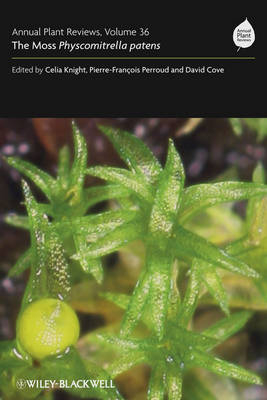
Annual Plant Reviews, The Moss Physcomitrella patens
Wiley-Blackwell (Verlag)
978-1-4051-8189-1 (ISBN)
The Moss Physcomitrella patens has rapidly become an experimental model of choice for many aspects of molecular, cell and developmental biology in plant sciences. With a recently sequenced genome, which has further fuelled interest and research, Physcomitrella is accruing various new labels, from ‘a green yeast’ to the Drosophila, Caenorhabditis or Zebra fish of plant sciences. A truly international collaboration, this timely volume brings together a selection of chapters each composed by experts in their field. The chapters included cover a broad range:
From those using P. patens as a marker against other species for evolutionary or ecological studies
To those investigating the unique features of P. patens, e.g. gene targeting
To those using moss, either as a comparator for other organisms or because of the ease of study in moss, to investigate standard biological processes
This landmark publication is essential reading for anyone studying plant evolutionary biology, genomics, molecular and cell biology and genetics. Libraries in all universities and research establishments, where biological and agricultural sciences are studied and taught, should have copies of this important book on their shelves.
Celia Knight is Senior Lecturer at the Faculty of Biological Sciences, University of Leeds, Leeds, UK. Pierre-François Perroud is Research Scientist at the Department of Biology, Washington University, St. Louis, USA. David Cove is Visiting Professor at both the Faculty of Biological Sciences, University of Leeds, Leeds, UK, and the Department of Biology, Washington University, St. Louis, USA
Contributors. Preface.
Glossary.
1. Putting Physcomitrella patens on the Tree of Life: The Evolution and Ecology of Mosses (Brent D. Mishler and Melvin J. Oliver).
1.1 Introduction to Physcomitrella.
1.2 The position of P. patens on the tree of life.
1.3 Relationships within the mosses.
1.4 Evolution and ecology of the mosses.
1.5 General implications for evolutionary processes in mosses.
2. The Genetic Basis of Natural Variation in Bryophyte Model Systems (Stuart F. McDaniel).
2.1 Introduction.
2.2 Genetic variation among bryophyte populations.
2.3 Mapping genes underlying natural variants.
2.4 Assigning genes to phenotypes.
3. Comparative Genomics (Stefan A. Rensing, Daniel Lang and Andreas D. Zimmer).
3.1 Introduction.
3.2 A short history of P. patens genomics.
3.3 Features of the P. patens nuclear genome.
3.4 Comparisons with seed plants and algae.
3.5 Computational resources for P. patens.
3.6 Conclusions and outlook.
4. Gene Targeting (Yasuko Kamisugi and Andrew C. Cuming).
4.1 Introduction.
4.2 Gene targeting in eukaryotes.
4.3 Gene targeting in P. patens: practical aspects.
4.4 Targeted gene replacement versus targeted insertion.
4.5 Mechanisms of gene targeting.
4.6 Unanswered questions and future prospects.
5. The Small RNAs of Physcomitrella patens: Expression, Function and Evolution (Michael J. Axtell).
5.1 Introduction to small RNAs.
5.2 Classes of small silencing RNAs.
5.3 Expression of P. patens small RNAs.
5.4 Biogenesis of P. patens small RNAs: Dicers, Slicers and other utensils.
5.5 Targets of P. patens small RNAs.
5.6 Evolution of plant miRNAs.
5.7 Conclusions.
6. Tip Growth in the Moss Physcomitrella patens (Magdalena Bezanilla and Pierre-Franc¸ois Perroud).
6.1 Introduction.
6.2 Morphology and structure of a tip cell.
6.3 Environmental signals affecting polar cell elongation.
6.4 Cellular structural components involved in polar cell elongation.
7. Gametangia Development in the Moss Physcomitrella patens (Rumiko Kofuji, Takeshi Yoshimura, Haruko Inoue, Keiko Sakakibara, Yuji Hiwatashi, Tetsuya Kurata, Tsuyoshi Aoyama, Kunihiko Ueda, and Mitsuyasu Hasebe).
7.1 Introduction.
7.2 Development of the gametangia.
7.3 Development of the gametangia after fertilization is accompanied by growth of the sporophyte.
7.4 Gene-trap lines with GUS expression in the gametangia.
7.5 Future prospects.
8. Chloroplasts (Mamoru Sugita and Setsuyuki Aoki).
8.1 Chloroplasts of Physcomitrella patens.
8.2 Plastid DNA.
8.3 Transcription of plastid genes by two plastid RNA polymerases PEP and NEP.
8.4 Rhythmic expression of the plastid PSBD gene.
8.5 Post-transcriptional regulation in plastids.
8.6 Plastid transformation.
8.7 Chloroplast import.
8.8 Plastid division.
8.9 Chloroplast movement.
9. Carbon and Energy Metabolism (Mattias Thelander, Anders Nilsson and Hans Ronne).
9.1 Introduction.
9.2 Carbon and energy allocation.
9.3 Sucrose metabolism and transport.
9.4 Hexose metabolism and transport.
9.5 Energy homeostasis and Snf1-related kinases.
9.6 Conclusions.
9.7 Technical note on database searches and tree construction.
10. Hormonal Regulation of Development by Auxin and Cytokinin in Moss (Klaus von Schwartzenberg).
10.1 Major plant hormone routes are established in bryophytes.
10.2 Auxin.
10.3 Cytokinin.
10.4 Auxin and cytokinin interaction.
10.5 Other growth regulating substances.
11. The Role of Abscisic Acid in Stress Tolerance (Sung Hyun Cho, Klaus von Schwartzenberg and Ralph Quatrano).
11.1 Introduction.
11.2 Tolerance of P. patens to abiotic stresses and the effects of ABA.
11.3 Physiological and morphological changes during the establishment of tolerance.
11.4 Expression of stress-related genes.
11.5 Global responses to stress at the transcription level.
11.6 The ABA-signalling pathway.
11.7 Conclusions.
12. Pathogenesis in Mosses (Michael Lawton and Hemalatha Saidasan).
12.1 Introduction.
12.2 Recent advances in molecular plant pathology.
12.3 Experimental advantages of P. patens.
12.4 Developing a P. patens pathosystem.
12.5 Responses of P. patens to infection.
12.6 Selecting P. patens genes for functional studies of disease.
12.7 Future directions and opportunities.
Index.
Color plates.
| Erscheint lt. Verlag | 15.5.2009 |
|---|---|
| Reihe/Serie | Annual Plant Reviews |
| Verlagsort | Hoboken |
| Sprache | englisch |
| Maße | 160 x 236 mm |
| Gewicht | 839 g |
| Themenwelt | Naturwissenschaften ► Biologie ► Botanik |
| Naturwissenschaften ► Biologie ► Evolution | |
| Weitere Fachgebiete ► Land- / Forstwirtschaft / Fischerei | |
| ISBN-10 | 1-4051-8189-3 / 1405181893 |
| ISBN-13 | 978-1-4051-8189-1 / 9781405181891 |
| Zustand | Neuware |
| Haben Sie eine Frage zum Produkt? |
aus dem Bereich


